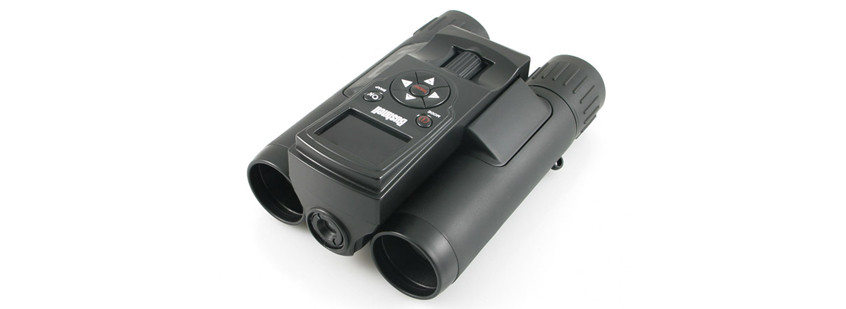Bushnell ImageView 8x30mm – $339
You only have to find a few customer reviews online to see this product has more than a few detractors. Yet as long as you’re well informed prior to purchase and have your expectations correctly calibrated, these binoculars will make a handy addition to the field kits of birders, botanists and beyond.
Out of the box the operation and use of these hi-tech glasses seems relatively straightforward, albeit with a few quirks. The first thing you’ll notice is that the camera is powered by three AAA batteries – a fact that some will love while others despise. The choice to use this type of battery most likely results from design concerns regarding size and weight, however the product is compatible with rechargeable lithium-ion AAAs and therefore this factor need only have a minimal impact on the total cost of ownership.
The next quirk arrives at the point the camera is switched on. ‘No card inserted’, flashes up on the screen. Again the result of design constraints, there is no on-board memory in the product. Instead, the ImageView relies on the user purchasing an SD card alongside it. However – possibly due to the AAA batteries – the maximum capacity of any card it can accept is 32 gigabytes. This may well be the point where many users begin to be feel disillusioned with the added technology of a camera to a pair of standard binoculars.
In reading a few reviews, it’s quite clear that the disappointment doesn’t stop here for many consumers, with a high proportion claiming that the eyepieces do not fold down close enough for them to easily see through them. While I was able to find a relatively comfortable viewing position, I did feel like it was only borderline functional and that any deviation from that specific angle meant I couldn’t see anything at all. This is the real flaw with the product, as it means that anyone without a larger than average distance between their pupils won’t find this product useful for its primary function (NB: I don’t think my eyes are set particularly far apart, but I can see how many people will have an issue even if their eyes are the tiniest bit closer together).
And therein lies the rub. It’s clear that these are still binoculars first, with a camera function as their secondary concern. In fact, the camera is just an eight megapixel point-and-shoot equivalent with no option to change focal length and only a basic range of exposure and white balance options (preset formats such as ‘sport’, ‘night’ and ‘landscape’ are included in the menu). Bushnell advertises the camera at 12 megapixels purely due to automatic digital rescaling, but it’s worth noting that this does nothing for the quality of the images produced. As a result, it’s clear there are a lot of people out there who have purchased this relatively expensive equipment thinking that it produces images similar to that which can be viewed through a binocular. Even worse, by adding in the bulky camera technology, Bushnell have sacrificed the range of motion of its fold-down eyecaps and this just serves to reduce its primary function.
The one truly useful addition to the included equipment in the box is a tabletop tripod that screws into the base of the ImageView. This is necessary as any small amount of shaking will further reduce image quality and it therefore makes a welcome inclusion. However, serious outdoor users may find the tabletop tripod too small to be useful in many situations and may wish to include a larger, adjustable tripod to accompany the binoculars in the field.
I trialled the ImageView during a visit to the Yarra Bend Park (north-east of Melbourne) thinking that roosting flying foxes would make decent subjects. As they appear on both sides of the Yarra, I was able to test the realistic range of the camera on an animal that wouldn’t be moving terribly fast. The tripod also came in handy as it helped me to steady my shots, but even then the results aren’t likely to win any nature photography awards.
I’ve included just two of the shots I took, as they are the best I managed to take and they also best demonstrate the qualities of the built-in camera. Both images were shot at an ISO of 400 with the format set to ‘Auto’.

This image was taken at a distance of around 15 metres from the subject.

These flying foxes were on the other side of the Yarra, photographed at a distance of roughly 30 metres.
Subjects photographed from 10 metres away or less were too blurry, and I also found many of my shots were affected by variable lighting. Ideally you should try to avoid shooting into the sunlight as this results in extremely dim photos.
The ultimate lesson here is to understand what you’re purchasing and, wherever possible, try before you buy. Bushnell’s binoculars are of good build quality and this is just as true of the ImageView, however they won’t be suitable for all users as a result of their compromised adjustability issue. However, assuming your eyes are set wide enough apart and you are after a device that can not only let you see at a distance while also capturing rough images of the vista around you, this will certainly prove useful. If you’re expecting to capture high-quality closeups of a fairy wren from 100 metres away, you’re setting yourself up for disappointment.


